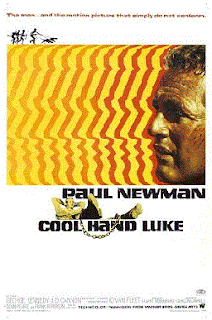Some movies have their main characters fight against
nature, some against armies and others have them fight against institutions,
always with the odds against them. Cool Hand Luke (1967) falls into that
last category as it follows a character who clashes against the often-troubled institution
that is the American prison system. It helps that the people in charge of said
prison are borderline sadists and that the convict rebelling against the system
is the legendary screen presence that is Paul Newman.
I had a great first impression of this movie even
though the first time I saw it was years ago while it had already started
playing on TV. The dialogue was dubbed in Spanish since I was living in South
America at the time, but once you get into the story it is hard to let go. Watching
Paul Newman defy and outsmart prison guards is not on par with all the
spectacle you see in cinemas nowadays, but it is certainly engaging. I recently
rewatched the movie, from beginning to end, on a classic movie channel to get the
full context for his character. It also gave me context as to why some of the
movie’s dialogue is used by Guns N’ Roses in their song Civil War. Now
there’s a true sign of achieving pop culture stardom.
Directed by Stuart Rosenberg, Cool Hand Luke set
in a Florida prison and is based on a novel, which is evidenced by the number
of characters. In addition to Newman’s Lucas “Luke” Jackson, there are 15
convicts at the prison. Look closely and you will spot young Harry Dean Stanton
and Dennis Hopper among them. For the Netflix generation, this will feel like
an all-white male version of Orange is the New Black. Just like that
much more progressive and ground-breaking show, the audience learns the ins and
outs of the prison through the eyes of first timers in the prison.
There is a hierarchy, first with the guards. The man
in charge is The Captain (Strother Martin), who rules over the prison thinking
he is stern and fair, but the convicts feel differently. Below him is the
Walking Boss Godfrey (Morgan Woodward) nicknamed “the man with no eyes” due to
his constant use of mirrored sunglasses. Looking at that man is like looking at
a soulless machine programmed to kill if you cross a line. Carr (Clifton James)
has more humanity as his job involves walking the floor of the prison barrack
to make sure everyone is in place and that there are no fights. He practically
lives with the convicts, which reminds him these are human beings after all.
The convicts have their own bit of hierarchy, with new
convicts at the bottom while at the very top sits prison leader Dragline
(George Kennedy). A tall and muscular man, Dragline is an imposing figure who
fears no one. When Luke does not respect his authority they have a fist fight
in front of the prisoners, which Dragline easily wins. Yet no matter how many
times Luke gets knocked down he keeps getting back up. This fight and other
incidents earn him the respect of Dragline, the other prisoners, and even some
guards.
It is fair to compare Luke’s life in prison to a
religious journey. As he encourages those around him to defy authority he is
punished for his actions. He does not spend 40 days in the desert, but after
his mother dies, he is locked up in a shed under the blazing sun to prevent him
from going to her funeral. When he does eventually try to escape, his punishment
includes having to wear chains and dig holes until he nearly passes out from
exhaustion. Every time he gets back up, the prisoners rally behind him as
though his words and actions are a gospel.
Although Luke is guilty, you cannot help but
sympathize with him and root for every escape attempt. For one thing his crime
is destroying parking meters while drunk, which some might say does not warrant
a prison sentence. True, Luke did break the law and every crime deserves a form
of punishment. However, when said punishment involves being locked in tiny shed
while your mother’s funeral services are taking place, being chained like an
animal, and being forced to perform hard labour for hours on end, you can’t help
but think there is something seriously wrong with the prison system.
I don’t know if the movie was an accurate depiction of prison at the time and place where it is set. Regardless, my opinion is that prisons should be a place of rehabilitation and not punishment through hard labour. You see the effect this punishment has on Luke’s body as he sweats from digging for hours and the sun burns his skin. When his fellow convicts sing in his support it is a rousing moment that has you cheering for the underdog. Cool Hand Luke can sometimes be a tough watch, but thanks in large part to Paul Newman giving one of his best performances it is a hopeful movie about resilience in the face of adversity.

Comments
Post a Comment